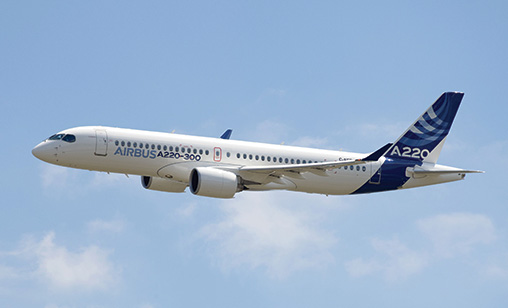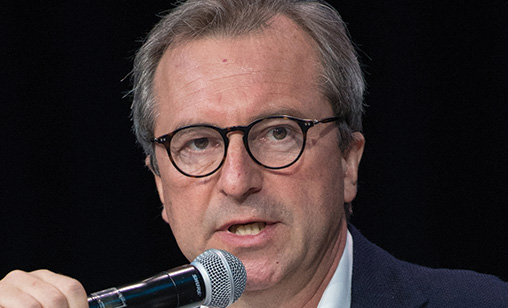News Backgrounder
Airbus embarks on big push for A220 business
Airbus welcomed its newest single aisle offering, the A220, in July after taking majority control of Bombardier’s C Series program. Can the global aircraft manufacturer revitalize sales of the re-christened regional aircraft? And can it convince more Asia-Pacific airlines to order it? Chief correspondent, Tom Ballantyne, reports from Toulouse.
September 1st 2018
Airbus has identified North America as the major market for its new A220 aircraft, a region where the manufacturer expected to generate 40% of all sales of the former Bombardier C Series regional jet. Read More » The question is: can the A220 achieve a major breakthrough in the world’s fastest growing airline region, the Asia-Pacific, where selling regional jets has proved to be an uphill battle?
The A220 type comes in two variants: A220-100 that fits into the 100-135 seat category and the A220-300 with a seat range of 130 to 160. Historically, Asia-Pacific airlines, whether full-service, low-cost or start-up, almost universally have built their fleets with larger A320s and B737s. Bombardier’s sole C Series customer in the region is Korean Air. The airline operates six A220-300s.
 |
Selling the regional jet in Asia will be a challenge, conceded head of sales for the A220, David Dufrenois, at a press conference in Toulouse shortly before the re-branded A220, resplendent in its Airbus livery, made its debut in July.
“We will try to convince some airlines with the A320 to consider the A220 at the same time. We also will have to tackle smaller regional airlines to see if we can help them to develop with the A220 with a module that is a bit less risky than the A320 and then go into the bigger league.”
Or, as head of product marketing for the A220, Antonio Da Costa, put it: “The -100 is our lowest risk aircraft. It is an ideal entry level aircraft offering low costs to operate and perfect to open small routes. It is a great growth path for regional carriers that want to go beyond 100 seats as traffic grows.”
Airbus took charge of the C Series program on July 1 with the formation of CSALP (C Series Aircraft Limited Partnership). Airbus owns 50.01%. Bombardier’s holding is approximately 34% and the government investment arm, Investissement Quebec, is the third partner with 16%.
The Airbus investment has breathed new life into a program that was failing. Bombardier spent more than $6 billion - $2 billion over budget - to develop the C Series after its launch in 2008. By late 2015 it had received a $1 billion bailout from the Quebec government to keep the program alive. At the time Toulouse took majority control, 402 C Series planes had been ordered and 38 delivered to customers from early 2017. If the A220 is to succeed it will need to win significantly more orders.
The existing production line in Mirabel Quebec is designed to deliver 120 jets annually, a target that is far from being achieved. A second production line is being built in Mobile, Alabama alongside the existing Airbus A320 Final Assembly Line. It is scheduled to open in 2020 and will have a production capacity of 50 to 60 aircraft a year.
 |
The joint venture has started well. A day after the A220 reveal in Toulouse, U.S. airline, Jet Blue, ordered 60 A220-300s. At the Farnborough Air Show a week later, 60 of the type were ordered by a planned U.S. start-up that has Jet Blue as an investor.
Airbus sales leaders are supremely confident in their ability to deliver more sales of the airplane. Head of customer Service for CSALP, Rob Dewar – known as the father of the C Series – said Airbus brings a world leading capability to the program.
“It has huge production rates and its ability and network of suppliers will be very helpful. I can see in the discussions we have had in the last seven months that there is a lot of capability and help that came [to us].
“Basically, we are going to build sales volume and ramp up the program. Volume will help us and our suppliers to reduce our downward earnings curve and lower production costs. We have had some preliminary discussions with our suppliers. They are very supportive. We are confident that together we are going to develop a very successful program.”
Dufrenois added: “I need to sell the aircraft. That is my job under the leadership of Airbus chief commercial officer, Eric Schultz. We have mobilized our sales teams worldwide and the feedback we have from the market is extremely positive. I don’t doubt we will be successful.”
Asked if Airbus could produce the new jet at a price customers are prepared to pay, he said: “yes, otherwise we would not continue an endeavor with this program. Airbus did a very thorough assessment of the market, including the pricing and the costing of the aircraft.”
Before the acquisition, Airbus had been dismissive about the C Series and had downplayed the potential of the 100-150 seat market. Forecast demand in the A220-A319 category in the next two decades is for 7,200 airplanes. with 6,100 of the jets predicted to be in the A220 size. Airbus expected to win at least 50% of these orders, it said.
 |
| 'The Asia-Pacific was probably “not the first market for the C Series, he said, but the region could still account for 15% to 20% of sales. It’s a great market for the 100-150 seater. You are right. The A320 has been very successful in the Asia-Pacific and still dominates the market. We will probably have to find a start-up, some airline that wants to start afresh with a new model' |
| David Dufrenois Airbus A220 head of sales |
Dufrenois did not think Airbus could be accused of underestimating the market in the past. “We did give our colleagues at Bombardier a very hard time when it came to the C Series versus the A319/320 to the extent we grabbed a lot of this market. But that was not actually to underestimate the market itself nor the program,” he said.
“John [Leahy, retired Airbus Commercial Aircraft sales chief, sales chief] said it was a cute little plane and I think he meant it. It is still a cute little plane. The point is that at one stage we had to make this decision. We have made this decision and we are going to make this C Series a great success.
“All the 100-seaters that came on the market were regional aircraft that were stretched, but Bombardier took the bet and the commitment to design a new aircraft specifically for the 100-seat market. It was extremely risky at the beginning because they were hitting the lowest part of the A320 segment.”
A challenge for Airbus is marketing the A220 as it is essentially the same size as the A319, an aircraft with a common type rating with the A320 series. Dufrenois said the A220 will be “fully integrated” into the A320 family.
He conceded that “at the beginning” there would not be full commonality between the two cockpits and no common type rating. That is something that could be worked out in the future, he said.
“First of all, there are a lot of similarities in the cockpits, side sticks and similar technologies. The first focus is ramping up the program, building sales and cutting our costs. Then we can look at opportunities in development with the Airbus family. It will not be done in one shot. Our first priority is on the ramp up,” he said.